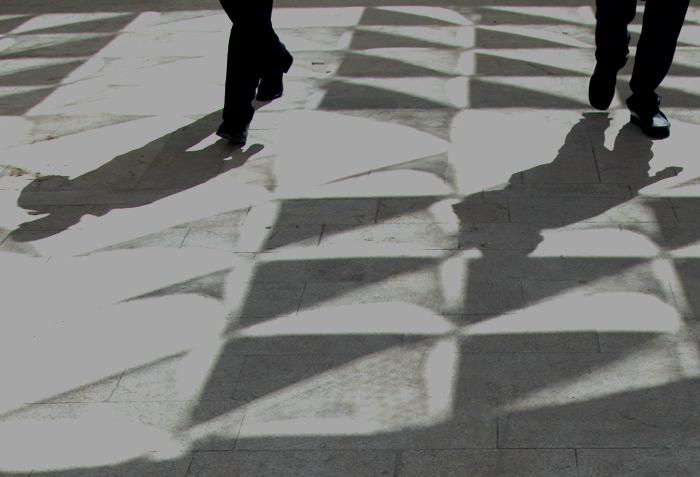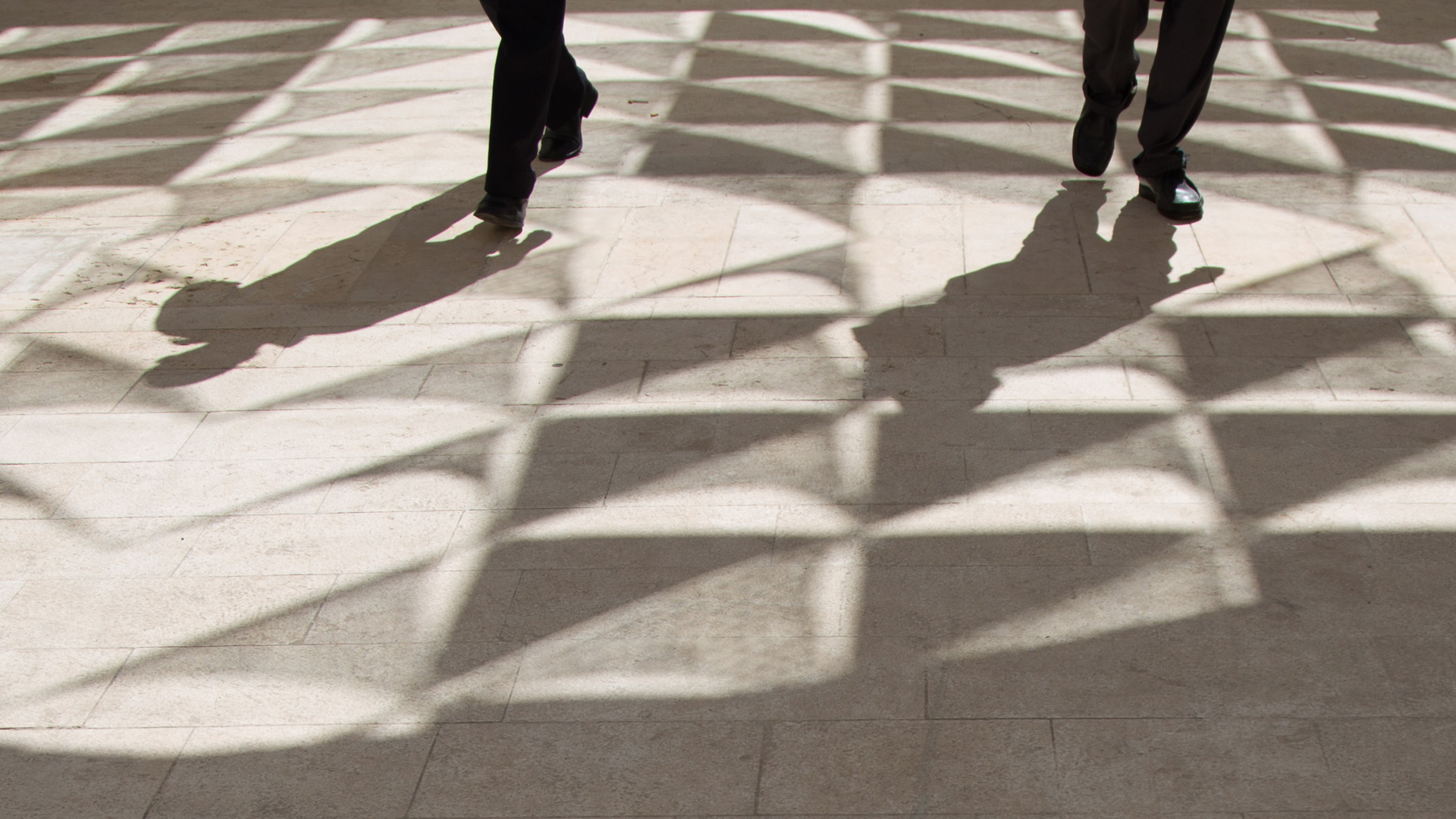

The Colonnade + The Bridge
Dina Haddadin, Khalid Ali, Norma Kopti
For 35 years, the Raghadan Bus Terminal has been a vital transportation terminal between Amman and major cities like Zarka and Karak. A public space used for all aspects of urban life from transport to trade and communication, the Terminal covers an area of 12,000 square meters. It was created with the help of Japanese funding back in 2006 as a permanent structure, and part of a large-scale downtown Amman renovation project. Although it was supposed to act as a modern commercial center, this plan never came to light, and the space has remained empty since.
All projects start in the streets as ephemeral as rumors. Both the Colonnade and the Bridge are temporary installations that weave the real and the imaginary, opening the opportunity to create new stories and meanings. Using materials borrowed from our everyday landscapes, the installations question the fleeting qualities and relationship between permanent material projects and the ideas abandoned and left suspended in time.
Design Work no. 1: The Colonnade
 As the entry for the Craft District, the Colonnade connects the public space and empty parking lots to the private body of the abandoned structure. As a temporary threshold, it was erected to prompt questions regarding the spaces between, the interruption and relocation inherent in any kind of transformation. The transient structure is built using 12 scaffolding towers arranged in the form of a grid and placed in the middle of the empty plaza. These pillars are spaced out to create a traditional architectural symbol of power with fragile materials. The gateways between the pillars, in turn, are triangular arches generated by weaving the pillars together with a 700m long piece of orange tarp, an industrial material usually used to veil construction sites. Appropriating a material that the public is used to seeing in different contexts, it is employed to create archways that mimic those on "Quraish Street," the route leading down to the Terminal.
As the entry for the Craft District, the Colonnade connects the public space and empty parking lots to the private body of the abandoned structure. As a temporary threshold, it was erected to prompt questions regarding the spaces between, the interruption and relocation inherent in any kind of transformation. The transient structure is built using 12 scaffolding towers arranged in the form of a grid and placed in the middle of the empty plaza. These pillars are spaced out to create a traditional architectural symbol of power with fragile materials. The gateways between the pillars, in turn, are triangular arches generated by weaving the pillars together with a 700m long piece of orange tarp, an industrial material usually used to veil construction sites. Appropriating a material that the public is used to seeing in different contexts, it is employed to create archways that mimic those on "Quraish Street," the route leading down to the Terminal.
Design Work no.2: The Bridge
 When left abandoned, suspended in time and space, a bridge structure, which is supposed to connect and celebrate a distance by demarking a beginning and an end, becomes a monument of emptiness in the city landscape. The Raghadan Bridge is one such example; because it was designed to connect the city fabric with the Raghadan Terminal structure. When the Terminal was never occupied, the bridge was never put into use.
When left abandoned, suspended in time and space, a bridge structure, which is supposed to connect and celebrate a distance by demarking a beginning and an end, becomes a monument of emptiness in the city landscape. The Raghadan Bridge is one such example; because it was designed to connect the city fabric with the Raghadan Terminal structure. When the Terminal was never occupied, the bridge was never put into use.
This monument of emptiness wraps and weaves 400 meters of the orange tarp used in construction sites through an existing structure. The floating orange bridge memorializes the temporal permanence of construction debris around the city and pays tribute to a structure that serves as a gateway to and from the city during the event.
Dina Haddadin is a practicing architect and self-taught visual artist living and working in Jordan. Dina's artistic practice is influenced by her architectural work and her examination of cities and places. A multidisciplinary artist working with techniques that vary from traditional to experimental, her multi-layered works, drawings, paintings, photography, sculpture and installations portray the quest for originality and belonging in an ever-changing urban landscape. These works reflect a study of places in transition and changing geographies.With her belief that real change and progress can be spearheaded by new definitions in construction, Haddadin has worked as an architect at Symbiosis Designs ltd., and has participated in a number of local and international exhibitions, Biennale exhibitions and residencies.
The Loom + The Canopies
Design Work no. 1: The Loom
Dina Haddadin, Khalid Ali, Norma Kopti
 With 3800m long ropes weaved and interlocked around it, the Pergola demarks the main atrium in The Raghadan Tourist Terminal. Each rope was weaved and carefully connected to the existing structure through order and rhythm to build a spatial loom connecting all floors with the “weight of the beater,” designed to mimic the typical loom beater.
With 3800m long ropes weaved and interlocked around it, the Pergola demarks the main atrium in The Raghadan Tourist Terminal. Each rope was weaved and carefully connected to the existing structure through order and rhythm to build a spatial loom connecting all floors with the “weight of the beater,” designed to mimic the typical loom beater.
The loom takes the form of a metal bar known as a reed, which contains a number of slots for the threads to pass through.The loom acts as a symbol for individual creation in any craft, an object that stands against the anonymity of mass-production and for the personalized production process. In this way, it stands against corporate labor and reverts power back to the "hands", shifting spatial views and occupying the voids of the existing structure.
Design Work no. 2: The Canopies
Dina Haddadin, Khalid Ali, Norma Kopti with the help of Diana Rayyan
 Inspired by local visual patterns, a modular triangular pattern was generated embracing sustainability and recycling to build each canopy with threads collected from waste plastic bags. The 1,600 triangles have been netted by a community of women in the Jerash refugee camp using a unique crochet technique and an abandoned craft that has all but disappeared with the dependence of a consumer economy on mass production. The ten canopies are a statement against dominant culture, mass-production, and capitalism. The installment reflects the empowerment and self-expression of craft and creativity, shifting values away from the machine and back into the hands of ordinary people. The canopies relocate personal meaning in an indifferent world, using fragments to weave together the body of each canopy. This is a social, performative piece that reflects the “close-knit” nature of local communities through the dying craft of crochet weaving.
Inspired by local visual patterns, a modular triangular pattern was generated embracing sustainability and recycling to build each canopy with threads collected from waste plastic bags. The 1,600 triangles have been netted by a community of women in the Jerash refugee camp using a unique crochet technique and an abandoned craft that has all but disappeared with the dependence of a consumer economy on mass production. The ten canopies are a statement against dominant culture, mass-production, and capitalism. The installment reflects the empowerment and self-expression of craft and creativity, shifting values away from the machine and back into the hands of ordinary people. The canopies relocate personal meaning in an indifferent world, using fragments to weave together the body of each canopy. This is a social, performative piece that reflects the “close-knit” nature of local communities through the dying craft of crochet weaving.


